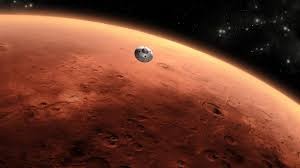Photo of Mars (licensing information here)
For a long time, Mars was thought to be inhabitable. However, there were always “what ifs” and hopes that one day Mars would be identified as a place where humans could survive and live comfortably. Recently, researchers found recurring slope lineae (RSL) on the Martian slopes of Mars to be caused by a salty liquid. We all know the most important aspect of life is water, something no one can live without and life on Earth cannot go on without. So, if water is crucial to life on Earth, wouldn’t that mean that finding water on Mars points towards the potential for life there as well?
Researchers used the Compact Reconnaissance Imaging Spectrometer for Mars (CRISM) aboard the Mars Reconnaissance Orbiter (MRO) in four different locations on Mars where RSL were present. There were signs of hydrated salts in all four locations during the seasons when RSL are largest and most prominent. RSL range from .5 to 5 meters wide, but have no limit to how expansive they are downslope. CRISM analyzes Mars at 3:00 p.m., which in Martian time is the hottest time of the day. This means that any liquid on the surface of Mars would have evaporated during this time, making it virtually impossible for the CRISM to identify water in its liquid form. However, hydrated salts precipitate from liquid water, meaning that even if there was no water found there at the time the CRISM analyzed that location, there was water there at one point in time. The salts associated with RSL are perchlorates, which lower the freezing point of water from 0° C (32° F) to -70° C (-94° F)! Researchers believe this points to a larger possibility for the stability of salt water on Mars.
However, even with all this excitement, researchers are still hesitant to make the claim that there are extremely high odds for the ability of life on Mars. Due to the low water activity of perchlorates, researchers believe it would be hard for any living organism to survive with this as their only water supply. Head researcher Lujendra Ojha cautions people who are tempted to jump to the conclusion Mars is now considered habitable for humans. However, people can still hope that one day Mars may offer a second home to human beings, especially with this new exiting find!
Main articles:
http://www.nature.com/ngeo/journal/vaop/ncurrent/full/ngeo2546.html
http://www.livescience.com/52322-water-flows-on-mars-discovery.html



agman
Izerstellar great article! I love learning about our solar system. I found a great website about Mars and the potential of water. Here: http://www.cosmicelk.net/Mars.htm. This website studies the craters in Mars and discusses the potential of H2O in them. An example is the the McLaughlin Crater. This crater is 57 miles (92 kilometers) in diameter and 1.4 miles (2.2 kilometers) deep. It is thought that there may be water within the bedrock.
jackuole
Very informative Izerstellar! New studies:
http://financialspots.com/2015/11/08/martian-atmosphere-was-stripped-by-solar-wind-nasa/
show that at one point Mars may have been warm and wet like Earth. Scientists believe that Mars’ atmosphere was stripped away millions of years ago by solar wind, which stripped the atmosphere of electrons. This created an atmosphere of charged ions which overtime are pulled away by passing magnetic fields, leaving Mars in the state we currently observe it in.